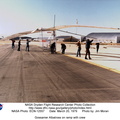
WIKIARCHIVES.SPACE
The Human Spaceflight Archive

The Gossamer Albatross II is seen here during a test flight at NASA's Dryden Flight Research Center, Edwards, California.
Information
- Taken in
- Edwards Air Force Base
- Author
- NASA
- Description
-
The Gossamer Albatross II is seen here during a test flight at NASA's Dryden Flight Research Center, Edwards, California.
The original Gossamer Albatross is best known for completing the first completely human powered flight across the English Channel on June 12, 1979. The Albatross II was the backup craft for the Channel flight.
It was fitted with a small battery-powered electric motor and flight instruments for the NASA research program in low-speed flight. NASA completed its flight testing of the Gossamer Albatross II and began analysis of the results in April, 1980.
During the six week program, 17 actual data gathering flights and 10 other flights were flown here as part of the joint NASA Langley/Dryden flight research program.
The lightweight craft, carrying a miniaturized instrumentation system, was flown in three configurations; using human power, with a small electric motor, and towed with the propeller removed. Results from the program contributed to data on the unusual aerodynamic, performance, stability, and control characteristics of large, lightweight aircraft that fly at slow speeds for application to future high altitude aircraft.
The Albatross' design and research data contributed to numerous later high altitude projects, including the Pathfinder.
- Created on
- Thursday 20 March 1980
- Source link
- https://www.dfrc.nasa.gov/Gallery/Photo/Albatross/index.html
- Visits
- 26
- Rating score
- no rate
- Rate this photo
- License
- Public Domain
- Modified by WikiArchives
- No (original)
- Downloads
- 0
Powered by Piwigo




